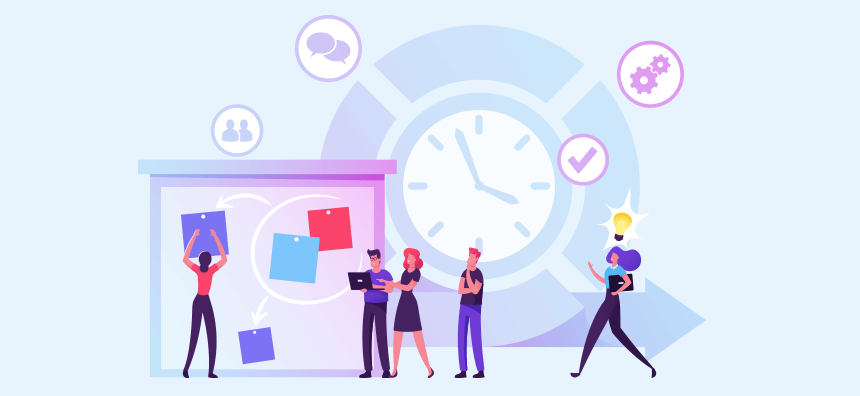
Click the button to start reading
5 Simple Methods for Shortening a Project Schedule
The schedule is the beating heart of every project. All project managers know how to make one but sometimes you need to do things quicker without reducing the scope of the project. It’s a good idea for PMs to know some schedule compression techniques.
You and your team may be able to shave off days, weeks, or months from the project schedule with the proper tips for doing so. There could be multiple opportunities where the project schedule can be reduced. As a project manager, it will be your responsibility to find them and help the team to implement changes.
In this article, we are going to look at new project management methods as well as the tried and tested ones like the Critical Path Method. Ultimately, the hope is to highlight areas where time can be saved on your project.
If you can plan ahead, fast-track tasks, and understand where slack time can be utilized, you’ll be able to hand in the deliverables early. No longer are project managers going to have to fight back unrealistic timelines, instead, they’ll make them a reality.
Now let’s take a look at 5 methods for shortening a project while maintaining consistency.

1. Define project deliverables and expectations before the project start date
Before you put together your team and start work on a project, you’ll need to plan. During the planning stages of the project, you will be able to identify areas where processes can be streamlined. At this point, you’ll set the key factors of the project including the general design, project deliverables, and expected work rate.
If the project manager can plan ahead and work out these key factors it means the team can get started as soon as the project begins. Otherwise, the team may have to figure out things like high-level requirements and the general design which slows them down at the start.
People have different work rates but if the expected rate is specified before the project starts, everyone will be on the same page. One great way to do this is by following Agile methodology, which is one of the most adaptable schedule compression techniques. We’ll get more into that in point 3.

2. Understand the critical path
The critical path is essential for deciding how long a project will take. So it makes sense that if you want a method for shortening a project schedule you should take a look at the critical path.
If you’re unsure what the critical path is, it’s the sequence of events that must occur from the start of the project until it is finished. In order to finish a project early, you’ll need to identify ways to shorten the critical path. Likewise, if the critical path is extended then the project will be delayed past the due date.
Defining the critical path is an excellent skill for project managers to have. A novice may not have the discipline needed to know what constitutes part of the path or not. Someone with a lot of experience and training will find it easier to identify ways to shorten the critical path.
Here are some ideas for you to consider:
- Ask your team if they can shave time off their longest tasks. Go straight to the source, the people working on the project. They may have ideas to speed up the phases they are working on.
- Use Gantt charts to input your estimates for deliverables. Adjust the tasks based on their dependencies. Make sure to avoid inputting parallels that simply can’t happen.
- The Gantt chart will help you to identify the critical path for the project. Please note that some projects can have more than one critical path. There will be some tasks that aren’t in any path.

3. Implement Agile methodologies
Agile is a framework for projects that was created for software development. The methodologies can be applied to lots of industries and are perfect for team-based projects. The main way it’s used for projects is by breaking them down into 2-4 week sprints.
Sprints are led by the product owner and supported by a Scrum Master who will be the most knowledgeable in Agile. Agile likes change and it’s well suited for teams to switch up how they work and learn as they go.
Sprints will consist of a variety of meetings such as:
- Sprint Backlog: This meeting will analyze the deliverables for the sprint based on the product backlog. The development team will then decide on outcomes for this sprint.
- Daily Scrum: The daily scrum will be a 15-30 minute standup meeting led by the Scrum Master. Team members will discuss their progress, plans for the day, and any hindrances they incurred.
- Sprint Review: The team will gather at the end of the sprint with the product owner and other stakeholders. Team members will present the deliverables for this sprint and the product owner can refine the product backlog.
- Sprint Retrospective: This meeting is about analyzing the previous sprint for inefficiencies. The goal is to improve the next sprint and make processes easier for teams.
If you split your project into sprints, you benefit from an inspect-and-adapt approach. Staying Agile involves input from the whole team which can improve work rates as everyone will be aware of how their work affects (or holds up) their colleagues.

4. Remove certain dependencies to fast-track work
It’s natural to plan your projects as a series of tasks to be done one after the other. The next task can’t start until its predecessor has been completed. In many instances this is logical and that helps you to define the critical path.
In other instances, they could be false dependencies and the tasks could actually be done in parallel with each other. If you can account for the overlap in work you may be able to shave days off the project.
One other way to remove dependencies is to reconsider what needs approval. Red tape like that can delay projects while waiting for things like designs to be approved. Even if the approval happens on time, the wait for it is time wasted and time that can be saved from your project schedule.

5. Make good use of slack time
As a project manager, you’ll need to find slack in the schedule and minimize where possible. Slack time refers to places in the schedule where tasks can be delayed without affecting the due date of the project. You may be tempted to hide slack time from your clients but this can have an adverse effect.
Slack will exist in any project but if you can identify it, you can start being more productive with that time. If you know that one of your team members will have some free time in their schedule, ask them to do additional tasks. You can also deploy team members to other areas to work on tasks in the critical path.
A good manager will be able to anticipate these moments and be able to remove the amount of slack that occurs in the project schedule.
Conclusion
Put these methods of shortening a project to use and you’ll be able to level up your skills as a project manager. How much time you can save depends on a lot of factors so you have to be realistic with your goals. However, these schedule compression techniques can help teams to shave weeks or even months off of their projects.
Impress your bosses by using logical steps to cut the time of the project you’re overseeing. Give your team more responsibilities by following Agile methodologies and asking for their help where slack is concerned. Your team will be the greatest asset to the project and they are key to shortening the time it takes to complete.
















